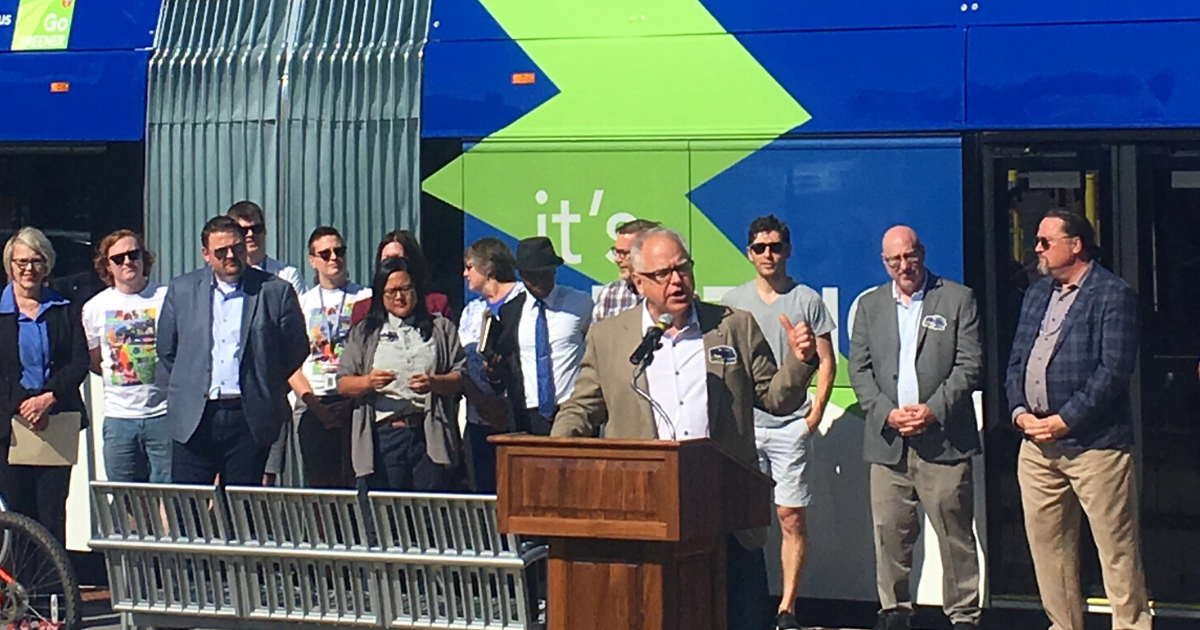Walz’s Budget Proposal Should Include Significant Investments in Transit | MinnPost
There are major opportunities in the upcoming months for the state to build toward a sustainable and equitable future for all Minnesotans, but Governor Walz needs to start now by including investments in transit as part of his budget proposal. Below, in a piece recently published by MinnPost, Move Minnesota’s Sam Rockwell and Sierra Club North Star Chapter’s Margaret Levin explain why investing in transit can’t wait. Keep reading to learn more about how transit funding can put Minnesota back on track to reduce carbon emissions and toward economic recovery.
Last week, Minnesota’s Pollution and Control Agency and the Department of Commerce revealed that Minnesota yet again missed greenhouse gas reduction targets. Rising automobile pollution is a primary cause of our shortfall. Gov. Tim Walz should reverse this trend when he releases his two-year budget proposal on Jan. 26. Significant investments in transit would curb climate pollution and — an important bonus — support much-needed economic recovery by expanding access to opportunities. It would save Minnesotans money and bring federal dollars to the state.
Transportation is the leading source of climate pollution in Minnesota because of the kind of vehicles we own and how much we drive. Several state entities acknowledge that we need to change: The Minnesota House Climate Action Plan calls for vehicle electrification and reducing the need to drive, and the Minnesota Department of Transportation’s Sustainable Transportation Advisory Council recommends clean vehicle investments and a statewide goal to reduce driving 20% by 2050 (a reduction level consistent with Minnesota-specific research and with targets in Delaware, California, and Washington state).
To lower emissions, provide alternatives to car use
Minnesota will get cleaner cars on the road with the clean cars rule. This is one important step, but the state is doing little to reduce how much Minnesotans have to drive. The only way to sufficiently lower emissions is to provide viable alternatives to car use. That means investing in transit.
Right now, metro-area transit just doesn’t work for too many people. For example, University of Minnesota researchers found that even from downtown Minneapolis, transit riders can access just 10% of the jobs of their car-driving counterparts in 30 minutes. This dissuades residents from using transit and creates huge barriers to opportunity for the disproportionately Black and brown community members who rely on our buses and trains.
And it’s not just those dependent on transit who are suffering. For Minnesotans who have to buy a car to keep a job or manage child care, transportation costs can be crushing. The American Automobile Association (AAA) estimates the annual cost of car ownership in 2019 was $9,300. This exorbitant expense contributes to the fact that 40% of Americans have less than $400 in their savings account and struggle to pay rent and put food on the table.
A truly comprehensive and high-quality regional transit system could relieve the need for car ownership, as it does in cities around the world. It would produce climate mitigation and a means for economic recovery. By our calculations, this kind of transit system — which could provide five-minute wait times for high-quality transit within half-a-mile of nearly everyone in the I-494/694 beltway, and which could expand quickly if based on Bus Rapid Transit expansions—would cost metro area residents just $185 per year.
A huge return on investment
For the many who could skip car ownership if transit worked better, that represents a 5,000% return on the $185 investment. Imagine being able to give residents more than $9,000 per year to invest in business start-ups, education, housing, retirement accounts and other spending that will help our neighbors and our struggling economy. It’s possible with the right state investments.
And it is not only the state that will be investing in Minnesota’s success. The Biden administration and Democratic Senate are planning a “trillions” dollar relief package, including a reported $20 billion for transit agencies. To take full advantage of this relief — and other likely investments in the coming years — Minnesota must be ready to build and must have money available for required local matching dollars. Failure to invest now could mean we forfeit enormous opportunity in the future.
The choice: rebuild Minnesota or double down
Walz has a choice in his budget and policy priorities this year: He can rebuild Minnesota and secure a just and sustainable future, or he can double down on our harmful, unjust, and unequal status quo, sliding into the “political impotence” a recent and devastating climate study attributes to failed climate progress.
We hope — for all Minnesotans — that the governor embraces this unique opportunity to deliver on his stated commitments to climate action and invest in transit for our future.
Take Action Today
Make sure Governor Walz and your state legislators know the importance of transit for climate and communities across the state.

